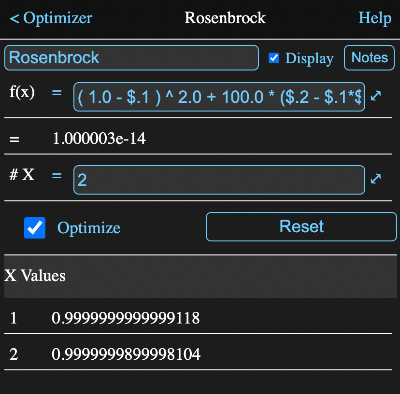Overview
The optimizer manipulates one or more output values to try and obtain the smallest possible scalar value for a single function that depends, either directly or indirectly, on those outputs. The algorithm used is the Powell method.
You must designate how many outputs the optimizer should produce. These will initially have values of 0 and their conversion unit type will be dimenionless.
These values will be available as parameters 1, 2 etc. and must be used to calculate the value determined by the formula in the f(x) field.
While the entire calculation could be contained in a single formula, more typically that formula references the values calculated by other tools that in turn eventually depend on the optimizer output values.
Information View
Below is an image of the information view of an optimizer for the classic Rosenbrock problem.

The fields are:
f(X) Formula
This formula field should contain a formula which calculates the scalar value to be minimized.
f(X) Value
The value currently calculated by the function is displayed immediately below its formula field.
Number of X Values
This formula field should contain or calculate the number of variables to be optimized.
The optimizer will provide output parameters named from "1" to this number and will adjust these parameters in an attempt to minimize the f(x) value.
Use these parameter values in formulas to calculate the actual values you wish adjusted.
Optimize Check Box
Turn this on to have the optimizer run.
While checked, the optimizer will automatically rerun if one of its outputs is requested after one of its inputs has changed.
Reset Button
This resets the output values to zero and also unchecks the optimize box.
X Values
This table contains the current output values.
Formula Parameters
Parameters that can be accessed in the form a.b where a is the tool name and b is the parameter name.
- x - the current output array
- n - output value n, where n is a number index into the output array (e.g. 2)
- solved - 1 if the optimization has completed successfully, otherwise empty
- html - a html code representation of the tool.
- notes - the notes for the tool
- myname - the name of the tool